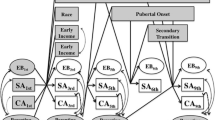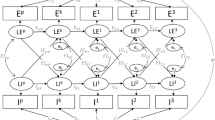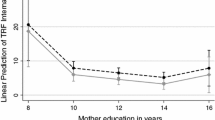Abstract
Early onset of internalizing and externalizing behavior problems is associated with persistent and more severe academic, social, and mental health challenges later in life. Understanding the factors that increase children’s risk of developing these behavior problems prior to the start of formal school is important for preventing their emergence and mitigating their effects. Using data from the Early Childhood Longitudinal Study Kindergarten Class of 2010–2011 (ECLS-K 2011), this study investigated how individual student demographic characteristics (i.e., gender, race/ethnicity, family SES) predict internalizing and externalizing behaviors at the start of kindergarten and whether geographic locale (i.e., city, suburb, town, rural) might moderate these relationships. Path analyses revealed that internalizing and externalizing behaviors were stable across the kindergarten year and that students’ levels of externalizing behaviors in the fall positively predicted internalizing behaviors in the spring. Results also showed that, at kindergarten entry, boys showed higher rates of externalizing and internalizing behaviors compared to girls, Black children showed higher rates of externalizing behaviors, but lower rates of internalizing behaviors compared to White children, and SES negatively predicted both forms of behavior problems. Moderation analyses revealed that risks of entering kindergarten with elevated rates of behavior problems varied across locales for boys, Black children, and children from low SES families. Implications for policy and practice are also discussed.


Similar content being viewed by others
References
Achenbach, T. M. (1991). Manual for the Child Behavior Checklist/4–18 and 1991 Profile. Burlington, VT: University of Vermont Department of Psychiatry.
Aguiar, A. L., Aguiar, C., Cadima, J., Correia, N., & Fialho, M. (2019). Classroom quality and children’s social skills and problem behaviors: Dosage and disability status as moderators. Early Childhood Research Quarterly, 49, 81–92.
Aloe, A. M., Shisler, S. M., Norris, B. D., Nickerson, A. B., & Rinker, T. W. (2014). A multivariate meta-analysis of student misbehavior and teacher burnout. Educational Research Review, 12, 30–44. doi:https://doi.org/10.1016/j.edurev.2014.05.003
Ashford, J., Smit, F., Van Lier, P. A., Cuijpers, P., & Koot, H. M. (2008). Early risk indicators of internalizing problems in late childhood: a 9-year longitudinal study. Journal of Child Psychology and Psychiatry, 49(7), 774–780. https://doi.org/10.1111/j.1469-7610.2008.01889.x
Bronfenbrenner, U. (1979). The ecology of human development: Experiments by nature and design. Harvard University Press.
Brown, J., Barbarin, O., & Scott, K. (2013). Socioemotional trajectories in Black boys between kindergarten and the fifth grade: The role of cognitive skills and family in promoting resiliency. American Journal of Orthopsychiatry, 83(2–3), 176–184. https://doi.org/10.1111/ajop.12027
Bulotsky-Shearer, R. J., & Fantuzzo, J. W. (2011). Preschool behavior problems in classroom learning situations and literacy outcomes in kindergarten and first grade. Early Childhood Research Quarterly, 26(1), 61–73. https://doi.org/10.1016/j.ecresq.2010.04.004
Campbell, S. B. (1995). Behavior problems in preschool children: A review of recent research. Journal of Child Psychology and Psychiatry, 36(1), 113–149. https://doi.org/10.1111/j.1469-7610.1995.tb01657.x
Carneiro, A., Dias, P., & Soares, I. (2016). Risk factors for internalizing and externalizing problems in the preschool years: Systematic literature review based on the child behavior checklist 1½–5. Journal of Child and Family Studies, 25(10), 2941–2953. https://doi.org/10.1007/s10826-016-0456-z
Collie, R. J., Martin, A. J., Nassar, N., & Roberts, C. L. (2019). Social and emotional behavioral profiles in kindergarten: A population-based latent profile analysis of links to socio-educational characteristics and later achievement. Journal of Educational Psychology, 111(1), 170–187. https://doi.org/10.1037/edu0000262
Coplan, R. J., Gavinski-Molina, M. H., Lagace-Seguin, D. G., & Wichmann, C. (2001). When girls versus boys play alone: Nonsocial play and adjustment in kindergarten. Developmental Psychology, 37(4), 464–474. https://doi.org/10.1037/0012-1649.37.4.464
De Marco, A., Vernon-Feagans, L., & Family Life Project Key Investigators. (2015). Child Care Subsidy Use and Child Care Quality in Low-Wealth. Rural Communities Journal of Family and Economic Issues, 36(3), 383–395.
Dodge, K. A., Pettit, G. S., & Bates, J. E. (1994). Socialization mediators of the relation between socioeconomic status and child conduct problems. Child Development, 65(2), 649–665. https://doi.org/10.1111/j.1467-8624.1994.tb00774.x
Duncan, G., & Magnuson, K. (2011). The nature and impact of early achievement skills, attention skills, and behavior problems. In G. J. Duncan, & R. J. Murnane (Eds.), Whither Opportunity: Rising Inequality, Schools, and Children’s Life Chances (pp. 47–69). Russell Sage.
Eisenberg, N., Cumberland, A., Spinrad, T. L., Fabes, R. A., Shepard, S. A., Reiser, M., Murphy, B. C., Losoya, S. H., & Guthrie, I. K. (2001). The relations of regulation and emotionality to children’s externalizing and internalizing problem behavior. Child Development, 72(4), 1112–1134. https://doi.org/10.1111/1467-8624.00337
Enders, C. K. (2001). The impact of nonnormality on full information maximum-likelihood estimation for structural equation models with missing data. Psychological Methods, 6(4), 352. https://doi.org/10.1037/1082-989X.6.4.352
Evans, B. E., Buil, J. M., Burk, W. J., Cillessen, A. H., & van Lier, P. A. (2018). Urbanicity is associated with behavioral and emotional problems in elementary school-aged children. Journal of Child and Family Studies, 27(7), 2193–2205. https://doi.org/10.1007/s10826-018-1062-z
Fanti, K. A., & Henrich, C. C. (2010). Trajectories of pure and co-occurring internalizing and externalizing problems from age 2 to age 12: findings from the National Institute of Child Health and Human Development Study of Early Child Care. Developmental Psychology, 46(5), 1159–1175. https://doi.org/10.1037/a0020659
Feil, E. G., Walker, H., Severson, H., & Ball, A. (2000). Proactive screening for emotional/behavioral concerns in Head Start preschools: Promising practices and challenges in applied research. Behavioral Disorders, 26(1), 13–25. https://doi.org/10.1177/019874290002600103
Fox, L., & Hemmeter, M. L. (2014). Implementing Positive Behavioral Intervention and Support. Pyramid Model Consortium.
Gilliam, W. S., Maupin, A. N., Reyes, C. R., Accavitti, M., & Shic, F. (2016). Do early educators’ implicit biases regarding sex and race relate to behavior expectations and recommendations of preschool expulsions and suspensions. Yale University Child Study Center, 9(28), 1–16.
Gilliom, M., & Shaw, D. S. (2004). Codevelopment of externalizing and internalizing problems in early childhood. Development and Psychopathology, 16(2), 313–333. doi:https://doi.org/10.1017/S0954579404044530
Ginsburg, G. S., & Silverman, W. K. (1996). Phobic and anxiety disorders in Hispanic and Caucasian youth. Journal of Anxiety Disorders, 10(6), 517–528. https://doi.org/10.1016/S0887-6185(96)00027-8
Gresham, F. M., & Elliott, S. N. (1990). Social Skills Rating System. American Guidance Service.
Hamre, B. K., & Pianta, R. C. (2001). Early teacher–child relationships and the trajectory of children’s school outcomes through eighth grade. Child Development, 72(2), 625–638. https://doi.org/10.1111/1467-8624.00301
Han, W. J. (2010). Bilingualism and socioemotional well-being. Children and Youth Services Review, 32(5), 720–731. https://doi.org/10.1016/j.childyouth.2010.01.009
Hancock, G. R., Mueller, R. O., & Stapleton, L. M. (2010). The reviewer’s guide to quantitative methods in the social sciences. Routledge. https://doi.org/10.4324/9780203861554
Hayward, C., & Sanborn, K. (2002). Puberty and the emergence of gender differences in psychopathology. Journal of Adolescent Health, 30(4), 49–58. https://doi.org/10.1016/S1054-139X(02)00336-1
Hofstra, M. B., & Verhulst, F. C. (2000). Continuity and change of psychopathology from childhood into adulthood: a 14-year follow-up study. Journal of the American Academy of Child & Adolescent Psychiatry, 39(7), 850–858. https://doi.org/10.1097/00004583-200007000-00013
Hosp, J. L., & Reschly, D. J. (2004). Disproportionate representation of minority students in special education: Academic, demographic, and economic predictors. Exceptional Children, 70(2), 185–199. https://doi.org/10.1177/001440290407000204
Huaqing Qi, C., & Kaiser, A. P. (2003). Behavior problems of preschool children from low-income families: Review of the literature. Topics in Early Childhood Special Education, 23(4), 188–216. https://doi.org/10.1177/02711214030230040201
Hull, P., Kilbourne, B., Reece, M., & Husaini, B. (2008). Community involvement and adolescent mental health: Moderating effects of race/ethnicity and neighborhood disadvantage. Journal of Community psychology, 36(4), 534–551.
Humphrey, J. L., & Root, E. D. (2017). Spatio-temporal neighborhood impacts on internalizing and externalizing behaviors in US elementary school children: Effect modification by child and family socio-demographics. Social Science & Medicine, 180, 52–61.
Ingersoll, R. M., & Smith, T. M. (2003). The wrong solution to the teacher shortage. Educational Leadership, 60(8), 30–33.
Joiner, T. E., Perez, M., Wagner, K. D., Berenson, A., & Marquina, G. S. (2001). On fatalism, pessimism, and depressive symptoms among Mexican-American and other adolescents attending an obstetrics gynecology clinic. Behavior Research and Therapy, 39, 887–896. https://doi.org/10.1016/S0005-7967(00)00062-0
Kaiser, A. P., Hancock, T. B., Cai, X., Michael, E., & Hester, P. P. (2000). Parent-reported behavioral problems and language delays in boys and girls enrolled in Head Start classrooms. Behavioral Disorders, 26(1), 26–41. https://doi.org/10.1177/019874290002600104
Kang, S. K., & Bodenhausen, G. V. (2015). Multiple identities in social perception and interaction: Challenges and opportunities. Annual Review of Psychology, 66, 547–574. https://doi.org/10.1146/annurev-psych-010814-015025
Keefer, P. B., Monroe, P. A., Atkinson, E. S., & Garrison, M. E. (1996). Childcare as an impediment to rural women’s labor force participation. Family Perspective, 30(3), 257–274.
Keenan, K., & Shaw, D. (1997). Developmental and social influences on young girls’ early problem behavior. Psychological Bulletin, 121(1), 95. https://doi.org/10.1037/0033-2909.121.1.95
Keiley, M. K., Bates, J. E., Dodge, K. A., & Pettit, G. S. (2000). A cross-domain growth analysis: Externalizing and internalizing behaviors during 8 years of childhood. Journal of Abnormal Child Psychology, 28(2), 161–179. https://doi.org/10.1023/A:1005122814723
Kessler, R. C., Petukhova, M., Sampson, N. A., Zaslavsky, A. M., & Wittchen, H. U. (2012). Twelve-month and lifetime prevalence and lifetime morbid risk of anxiety and mood disorders in the United States. International Journal of Methods in Psychiatric Research, 21(3), 169–184. doi:https://doi.org/10.1002/mpr.1359
Koplewicz, H. S., Gurian, A., & Williams, K. (2009). The era of affluence and its discontents. Journal of the American Academy of Child and Adolescent Psychiatry, 48, 1053–1055. DOI: https://doi.org/10.1097/CHI.0b013e3181b8be5c
Lawson, G. M., McKenzie, M. E., Becker, K. D., Selby, L., & Hoover, S. A. (2019). The core components of evidence-based social emotional learning programs. Prevention Science, 20(4), 457–467. https://doi.org/10.1007/s11121-018-0953-y
Leve, L. D., Kim, H. K., & Pears, K. C. (2005). Childhood temperament and family environment as predictors of internalizing and externalizing trajectories from ages 5 to 17. Journal of Abnormal Child Psychology, 33(5), 505–520. https://doi.org/10.1007/s10802-005-6734-7
Leventhal, T., & Brooks-Gunn, J. (2000). The neighborhoods they live in: the effects of neighborhood residence on child and adolescent outcomes. Psychological Bulletin, 126(2), 309. DOI: https://doi.org/10.1037//0033-2909.126.2.309
Liu, J. (2004). Childhood externalizing behavior: Theory and implications. Journal of Child and Adolescent Psychiatric Nursing, 17(3), 93–103. https://doi.org/10.1111/j.1744-6171.2004.tb00003.x
Loth, A. K., Drabick, D. A., Leibenluft, E., & Hulvershorn, L. A. (2014). Do childhood externalizing disorders predict adult depression? A meta-analysis. Journal of Abnormal Child Psychology, 42(7), 1103–1113. https://doi.org/10.1007/s10802-014-9867-8
Luthar, S. S., & Barkin, S. H. (2012). Are affluent youth truly “at risk”? Vulnerability and resilience across three diverse samples. Development and Psychopathology, 24(2), 429–449. doi: https://doi.org/10.1017/S0954579412000089
Magnuson, K. A., & Waldfogel, J. (2005). Early childhood care and education: Effects on ethnic and racial gaps in school readiness. The Future of Children, 15(1), 169–196.
Mendelson, T., Kubzansky, L. D., Datta, G. D., & Buka, S. L. (2008). Relation of female gender and low socioeconomic status to internalizing symptoms among adolescents: A case of double jeopardy? Social Science & Medicine, 66(6), 1284–1296. https://doi.org/10.1016/j.socscimed.2007.11.033
Mesman, J., Bongers, I. L., & Koot, H. M. (2001). Preschool developmental pathways to preadolescent internalizing and externalizing problems. The Journal of Child Psychology and Psychiatry and Allied Disciplines, 42(5), 679–689. doi:https://doi.org/10.1017/S0021963001007351
Morgan, P. L., Farkas, G., & Wu, Q. (2009). Kindergarten predictors of recurring externalizing and internalizing psychopathology in the third and fifth grades. Journal of Emotional and Behavioral Disorders, 17(2), 67–79. https://doi.org/10.1177/1063426608324724
Muthén, L. K., & Muthén, B. (2017). Mplus user’s guide: Statistical analysis with latent variables, user’s guide. Muthén & Muthén.
National Center for Education Statistics (2001). Combined User’s Manual for the ECLS-K Base Year Public-Use Data Files and Electronic Codebook (NCES-2001- 029 revised). https://nces.ed.gov/pubsearch/pubsinfo.asp?pubid=2001029rev
National Center for Education Statistics (2006). Rural Education in America - Definitions. nces.ed.gov/surveys/ruraled/definitions.asp
Neidell, M., & Waldfogel, J. (2010). Cognitive and noncognitive peer effects in early education. The
Review of Economics and Statistics, 92(3),562–576. https://doi.org/10.1162/REST_a_00012
Olson, S. L., Sameroff, A. J., Kerr, D. C., Lopez, N. L., & Wellman, H. M. (2005). Developmental foundations of externalizing problems in young children: The role of effortful control. Development and Psychopathology, 17(1), 25–45. doi:https://doi.org/10.1017/S0954579405050029
Oswald, D. P., Coutinho, M. J., Best, A. M., & Nguyen, N. (2001). Impact of sociodemographic characteristics on the identification rates of minority students as having mental retardation. Mental Retardation, 39(5), 351–367. https://doi.org/10.1352/0047-6765(2001)039<0351:IOSCOT>2.0.CO;2
Oswald, D. P., Coutinho, M. J., Best, A. M., & Singh, N. N. (1999). Ethnic representation in special education: The influence of school-related economic and demographic variables. The Journal of Special Education, 32(4), 194–206. https://doi.org/10.1177/002246699903200401
Padilla, C. M., Cabrera, N., & West, J. (2017). The development and home environments of low-income Hispanic children: Kindergarten to third grade. Child Trends: The National Research Center on Hispanic Children and Families
Pine, D. S., Cohen, P., Gurley, D., Brook, J., & Ma, Y. (1998). The risk for early-adulthood anxiety and
depressive disorders in adolescents with anxiety and depressive disorders.Archives of General
Psychiatry, 55(1),56–64. doi:https://doi.org/10.1001/archpsyc.55.1.56
Raadal, M., Milgrom, P., Cauce, A. M., & Mancl, L. (1994). Behavior Problems in 5 – to 11-Year-Old Children from Low-Income Families. Journal of the American Academy of Child & Adolescent Psychiatry, 33(7), 1017–1025. https://doi.org/10.1097/00004583-199409000-00013
Reiss, F. (2013). Socioeconomic inequalities and mental health problems in children and adolescents: a systematic review. Social Science & Medicine, 90, 24–31. https://doi.org/10.1016/j.socscimed.2013.04.026
Reynolds, C. R., Kamphaus, R. W., & Vannest, K. J. (2015). BASC3: Behavior assessment system for children. PscyhCorp.
Roberts, R. E., Roberts, C. R., & Chen, Y. R. (1997). Ethnocultural differences in prevalence of adolescent depression. American Journal of Community Psychology, 25(1), 95–110. https://doi.org/10.1023/A:1024649925737
Robinson, G. G., Bursuck, W. D., & Sinclair, K. D. (2013). Implementing RTI in two rural elementary schools: Encouraging beginnings and challenges for the future. Rural Educator, 34(3), 1–9. https://doi.org/10.35608/ruraled.v34i3.394
Rucinski, C. L., Brown, J. L., & Downer, J. T. (2018). Teacher–child relationships, classroom climate, and children’s social-emotional and academic development. Journal of Educational Psychology, 110(7), 992–1004. https://doi.org/10.1037/edu0000240
Russo, M. F., & Beidel, D. C. (1994). Comorbidity of childhood anxiety and externalizing disorders: Prevalence, associated characteristics, and validation issues. Clinical Psychology Review, 14(3), 199–221. https://doi.org/10.1016/0272-7358(94)90008-6
Schaefer, A. P., Mattingly, M. J., & Johnson, K. M. (2016). Child poverty is higher and more persistent in rural America. https://scholars.unh.edu/cgi/viewcontent.cgi?article=1265&context=carsey
Sellström, E., & Bremberg, S. (2006). The significance of neighbourhood context to child and adolescent health and well-being: a systematic review of multilevel studies. Scandinavian Journal of Public Health, 34(5), 544–554. DOI: https://doi.org/10.1080/14034940600551251
Skiba, R. J., Horner, R. H., Chung, C. G., Rausch, M. K., May, S. L., & Tobin, T. (2011). Race is not neutral: A national investigation of African American and Latino disproportionality in school discipline. School Psychology Review, 40(1), 85–107. https://doi.org/10.1080/02796015.2011.12087730
Smalley, K. B., Smalley, B., Thresa Yancey, K., Warren, C., Naufel, J. C., Ryan, K., R., & Pugh, J. L. (2010). Rural mental health and psychological treatment: A review for practitioners. Journal of Clinical Psychology, 66(5), 479–489. doi:https://doi.org/10.1002/jclp.20688
Sutcher, L., Darling-Hammond, L., & Carver-Thomas, D. (2016). A coming crisis in teaching? Teacher supply, demand, and shortages in the US. Learning Policy Institute.
Swenson, K. (2008). “Child Care Arrangements in Urban and Rural Areas.” Washington, DC: US Department of Health and Human Services, Office of the Assistant Secretary for Planning and Evaluation. https://aspe.hhs.gov/reports/child-care-arrangements-urban-rural-areas-0
Thomson, K. C., Richardson, C. G., Gadermann, A. M., Emerson, S. D., Shoveller, J., & Guhn, M. (2019). Association of Childhood Social-Emotional Functioning Profiles at School Entry With Early-Onset Mental Health Conditions. JAMA Network Open, 2(1), e186694. doi:https://doi.org/10.1001/jamanetworkopen.2018.6694
Thijs, J. T., Koomen, H. M., de Jong, P. F., van der Leij, A., & van Leeuwen, M. G. (2004). Internalizing behaviors among kindergarten children: Measuring dimensions of social withdrawal with a checklist. Journal of Clinical Child and Adolescent Psychology, 33(4), 802–812. https://doi.org/10.1207/s15374424jccp3304_15
Tourangeau, K., Nord, C., Lê, T., Sorongon, A. G., Hagedorn, M. C., Daly, P., & Najarian, M. (2015). Early Childhood Longitudinal Study, Kindergarten Class of 2010-11 (ECLS-K: 2011). User’s Manual for the ECLS-K: 2011 Kindergarten Data File and Electronic Codebook, Public Version. NCES 2015-074. National Center for Education Statistics.
U.S. Public Health Service. Office of the Surgeon General (2000). Report of the Surgeon General’s Conference on Children’s Mental Health: A national action agenda. Health and Human Services Department.
Waldfogel, J., & Washbrook, E. (2011). Early years policy. Child Development Research, 2011. doi:https://doi.org/10.1155/2011/343016
Willner, C. J., Gatzke-Kopp, L. M., & Bray, B. C. (2016). The dynamics of internalizing and externalizing comorbidity across the early school years. Development and Psychopathology, 28(4), 1033–1052. doi:https://doi.org/10.1017/S0954579416000687
Wood, J. L., Essien, I., & Blevins, D. (2020). Black males in kindergarten: The effect of social skills on close and conflictual relationships with teachers. Journal of African American Males in Education, 8(2), 30–50.
Wynn, S. R., Carboni, L. W., & Patall, E. A. (2007). Beginning teachers’ perceptions of mentoring, climate, and leadership: Promoting retention through a learning communities perspective. Leadership and Policy in Schools, 6(3), 209–229. doi:https://doi.org/10.1080/15700760701263790
Zahn-Waxler, C., Shirtcliff, E. A., & Marceau, K. (2008). Disorders of childhood and adolescence: Gender and psychopathology. Annual Review of Clinical Psychology, 4, 275–303. https://doi.org/10.1146/annurev.clinpsy.3.022806.091358
Conger, R. D. (2013). Rural children at risk. Monographs of the Society for Research in Child Development, 78(5), 127-138.
Thiede, B. C., Kim, H., and Valasik, M. (2017). “Concentrated Poverty Increased in Both Rural and Urban Areas Since 2000, Reversing Declines in the 1990s.” University of New Hampshire Carsey School of Public Policy. https://scholars.unh.edu/cgi/viewcontent.cgi?referer=&httpsredir=1&article=1324&context=carsey
Rothwell, D. W., & Thiede, B. C. (2018). Child Poverty in Rural America. IRP Focus, 34(3), 20-29.
Author information
Authors and Affiliations
Corresponding author
Additional information
Publisher’s Note
Springer Nature remains neutral with regard to jurisdictional claims in published maps and institutional affiliations.
Rights and permissions
Springer Nature or its licensor holds exclusive rights to this article under a publishing agreement with the author(s) or other rightsholder(s); author self-archiving of the accepted manuscript version of this article is solely governed by the terms of such publishing agreement and applicable law.
About this article
Cite this article
Ross, R., Starrett, A. & Irvin, M.J. Examining the Relationships Between Kindergarteners’ Demographic Characteristics and Behavior Problems Across Geographic Locale. Early Childhood Educ J 51, 1427–1439 (2023). https://doi.org/10.1007/s10643-022-01391-6
Accepted:
Published:
Issue Date:
DOI: https://doi.org/10.1007/s10643-022-01391-6




